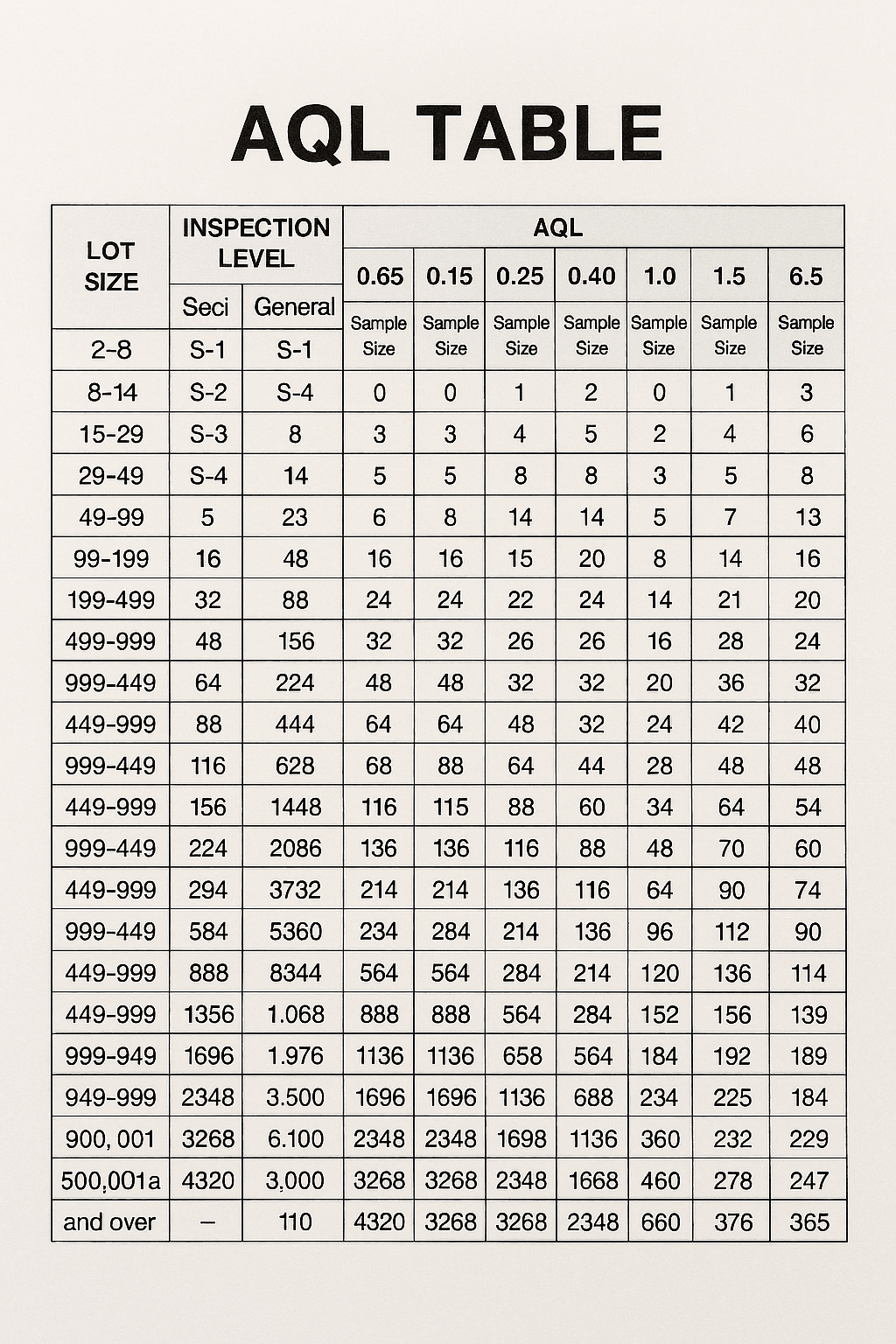Introduction
In the world of manufacturing, maintaining a consistent standard of quality is paramount. One of the key methodologies employed to achieve this is AQL sampling, which stands for Acceptable Quality Level sampling. This statistical approach allows quality control inspectors to determine whether a batch meets predefined quality standards, ensuring that products are safe and reliable for consumers.
Understanding AQL Sampling Basics
AQL sampling is a systematic method used in quality inspection to evaluate the quality of goods by inspecting a representative sample from a larger batch. The essence of this technique lies in its ability to provide an acceptable level of defects within sampled items, thus balancing efficiency and thoroughness in quality assurance processes. By utilizing AQL tables, quality assurance inspectors can make informed decisions about whether to accept or reject shipments based on established criteria.
Importance of Quality Control in Manufacturing
Quality control plays an essential role in manufacturing as it directly impacts customer satisfaction and brand reputation. By implementing robust quality auditing practices, companies can identify defects early on and mitigate risks associated with poor-quality products reaching the market. This proactive approach not only enhances product reliability but also fosters trust among consumers, which is invaluable in today's competitive landscape.
Overview of Inspection Levels
AQL sampling encompasses three primary levels: normal sampling, reduced sampling, and tightened sampling—each designed for specific scenarios based on risk assessment and historical data analysis. Normal sampling serves as the baseline for most inspections; however, reduced or tightened levels may be warranted depending on previous performance metrics or specific concerns raised during audits. Understanding these inspection levels allows quality control inspectors to tailor their approaches effectively, ensuring optimal results while maintaining compliance with industry standards.
First Level: Normal Sampling

In the world of quality control, normal sampling serves as the foundational approach for assessing product quality. This method is pivotal in ensuring that goods meet the acceptable quality level (AQL) before they reach consumers. By employing normal sampling techniques, quality assurance inspectors can efficiently identify defects and maintain high standards in manufacturing processes.
What is Normal Sampling in AQL?
Normal sampling in AQL refers to the standard procedure used to evaluate a batch of products against predetermined quality criteria. It involves selecting a random sample from a larger lot and inspecting it to determine if it meets the acceptable quality level. This method strikes a balance between thoroughness and efficiency, allowing quality control inspectors to make informed decisions without examining every single item.
The AQL table plays a crucial role here, providing guidelines on how many units should be inspected based on the lot size and desired confidence levels. For instance, if an inspector is evaluating a batch of 1,000 items with an AQL of 1%, they would use the table to determine how many samples need to be checked for defects. This systematic approach helps ensure that even with limited inspection resources, manufacturers can uphold their commitment to quality assurance.
How Quality Control Inspectors Use AQL Tables
Quality control inspectors rely heavily on AQL tables as essential tools for determining sample sizes and acceptance criteria during inspections. When faced with varying lot sizes and different acceptable defect rates, these tables simplify decision-making processes by providing clear benchmarks for action. By using these tables effectively, inspectors can maintain consistency across multiple inspections while adapting their methods according to specific production needs.
For example, when inspecting a batch of toys intended for children, an inspector may refer to the AQL table tailored for safety-related products—ensuring that any potential risk factors are closely monitored through proper sampling techniques. The use of these tables not only streamlines operations but also instills confidence among stakeholders regarding product reliability and safety standards. Ultimately, this structured approach enhances overall efficiency in quality auditing practices.
Benefits of Normal Sampling for Quality Assurance
Normal sampling offers numerous benefits that contribute significantly to effective quality assurance strategies within manufacturing environments. One key advantage is its ability to provide reliable insights into product defects without incurring excessive time or resource costs—allowing companies to allocate their efforts more strategically across various production lines. Moreover, by adhering strictly to established AQL guidelines during inspections, organizations can foster greater trust among consumers regarding product integrity.
Another benefit lies in its adaptability; normal sampling can be applied across diverse industries—from electronics to textiles—making it a versatile tool within any manufacturer's toolkit for maintaining high-quality standards. Additionally, regular implementation of normal sampling reinforces continuous improvement initiatives by identifying recurring issues that may require further investigation or process adjustments by quality control teams.
By embracing normal sampling as part of their broader quality control framework, organizations are better positioned not only to meet customer expectations but also drive innovation through enhanced operational efficiencies over time.
Second Level: Reduced Sampling

Reduced sampling is a strategic approach in quality control that allows inspectors to streamline their efforts while still maintaining effective quality assurance. This method is often employed when the production process demonstrates consistent adherence to acceptable quality levels, reducing the need for exhaustive inspections. Understanding when and how to utilize reduced sampling can significantly enhance efficiency without compromising product integrity.
What Triggers Reduced Sampling?
Reduced sampling typically comes into play when a manufacturer has demonstrated a stable production process with consistently high-quality outputs. If previous inspection results show that the defect rates are well below the acceptable quality level, it may trigger a shift from normal to reduced sampling. Additionally, if there are no significant changes in materials, processes, or suppliers, this can also lead to a decision for reduced sampling as part of an ongoing commitment to quality control.
The Role of Quality Auditing in Reduced Sampling
Quality auditing plays a crucial role in determining whether reduced sampling is appropriate for a given situation. Quality assurance inspectors will conduct audits to assess compliance with established standards and identify any potential risks that could affect product quality. These audits provide valuable insights into whether the conditions warrant reduced sampling or if further scrutiny is needed through more rigorous inspection methods.
Advantages of a Reduced Sampling Approach
The advantages of adopting a reduced sampling approach are manifold and can lead to significant efficiencies within the manufacturing process. By minimizing inspection time and resources while still adhering to quality control standards, companies can reduce operational costs without sacrificing product reliability. Furthermore, this method fosters trust in the manufacturing process as it reflects confidence in maintaining acceptable quality levels over time, ultimately benefiting both producers and consumers alike.
Third Level: Tightened Sampling

Tightened sampling is a critical approach in quality control that comes into play when the stakes are high, and the acceptable quality level (AQL) must be stringently monitored. This method is often implemented in situations where previous inspections have highlighted issues, or when there’s a significant risk of defects impacting customer satisfaction. Quality assurance inspectors utilize tightened sampling to ensure that any potential problems are caught early, thereby safeguarding both product integrity and brand reputation.
When to Implement Tightened Sampling?
Tightened sampling should be considered when there is an increase in defect rates during previous inspections or if there are concerns about the consistency of the manufacturing process. For example, if a series of normal sampling inspections reveal unexpected nonconformance with quality standards, it may trigger the need for tighter scrutiny through tightened sampling. Additionally, if new suppliers or production methods are introduced, quality control inspectors may opt for this approach to mitigate risks associated with untested variables.
Quality Control Inspector Insights on Tightened Sampling
Quality control inspectors play a pivotal role in executing tightened sampling effectively. They rely on AQL tables to determine sample sizes and acceptance criteria specific to the heightened inspection level, ensuring that every unit is scrutinized more closely than during normal sampling procedures. Inspectors also emphasize communication with manufacturers; by providing feedback on defects found during tightened inspections, they help drive improvements in production processes and foster a culture of continuous quality improvement.
Risks and Rewards of Tightened Sampling
While tightened sampling can significantly enhance product quality assurance, it does come with its own set of challenges and rewards. The primary risk lies in increased costs associated with more frequent inspections and potentially slower production timelines due to intensified scrutiny. However, the rewards often outweigh these risks; by catching defects early through diligent quality auditing practices, businesses can avoid costly recalls or damage to their brand image resulting from poor-quality products reaching consumers.
Conclusion

In summary, understanding AQL sampling levels is crucial for effective quality control in manufacturing. Each level—normal, reduced, and tightened—serves a specific purpose in ensuring that products meet the acceptable quality level set by industry standards. By leveraging AQL tables and insights from quality control inspectors, manufacturers can enhance their quality assurance processes and maintain high standards.
Key Takeaways on AQL Sampling Levels
AQL sampling provides a structured approach to evaluating product quality through various inspection levels tailored to specific circumstances. Normal sampling is ideal for routine checks, while reduced sampling is triggered by consistent quality performance, allowing for efficiency without sacrificing standards. Tightened sampling comes into play when issues arise, ensuring that any potential defects are caught early on—each level plays a pivotal role in maintaining the integrity of the production process.
The Critical Role of Quality Inspections
Quality inspections are at the heart of successful manufacturing operations, acting as the frontline defense against defects and inconsistencies. Quality control inspectors utilize AQL sampling techniques to assess whether products meet predetermined acceptable quality levels before they reach consumers. This proactive approach not only safeguards brand reputation but also fosters customer trust through consistent delivery of high-quality products.
How China Inspection Pro Enhances Quality Assurance
China Inspection Pro stands out as a leader in enhancing quality assurance through meticulous application of AQL sampling methods and rigorous quality auditing practices. Their team of experienced quality assurance inspectors ensures that every product undergoes thorough evaluation using established AQL tables, providing clients with confidence in their supply chain management. By partnering with China Inspection Pro, businesses can streamline their quality control processes while achieving optimal results in product reliability.
